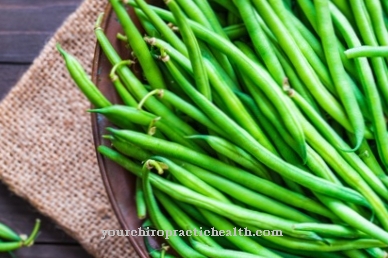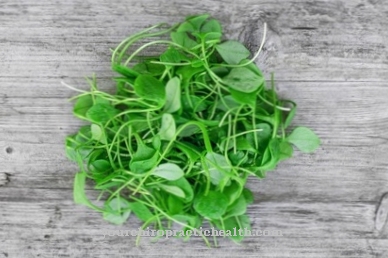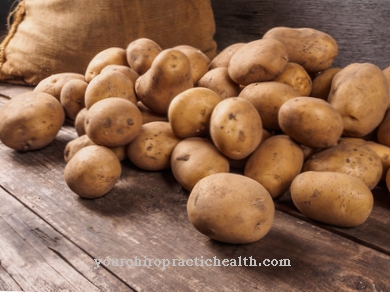The Lima bean (Phaseolus lunatus), also called Giants- or Moon bean is called, probably comes from Peru. These are very large white bean kernels that were grown by the Incas in the past. The lima bean then spread around the world through the slave traders and offers not only a variety of uses in the kitchen, but also health benefits.
What you should know about the lima bean

The lima bean belongs to the legume family and is genetically related to the green bean. It originates from Central America and the Andean region of South America. It is believed that it was cultivated independently twice. In the Andes, around 2,000 BC. The large-seeded Lima bean and around 800 BC. The small-seeded lima bean was cultivated in Central America.
Over the centuries it spread to North America. It came to Europe through the Spanish in the 16th century. Nowadays, the Lima bean is mainly grown in the highlands in northern Peru. The lima bean needs a certain amount of warmth to fully mature. Therefore, cultivation in Central Europe is only possible with little economic success.
There is a small and a larger subspecies of the bean. The larger species is the lima bean and the smaller is the moon bean. The lima bean can be 2 to 6 inches long. It is white, cream-colored or dark, as well as kidney-shaped, oval to round. After cooking, the bean, which has a mild taste, retains its shape, making it an ideal companion for a soup, stew or salads, but the core becomes soft and floury. The lima bean therefore ends up in stores in Germany mostly as imported goods and in a dried state. Preserves mostly come from France, Italy, India or Africa.
Importance to health
The lima bean has numerous health benefits. For example, it is an excellent source of plant-based protein for vegans and vegetarians. The proteins in the bean are also digested better by the body than the protein sources in meat.
The lima bean contains all of the amino acids the body needs. Since it is also very filling, it is suitable for people who want to keep their weight under control. In addition, the lima bean is an optimal source of iron, which is one of the essential trace elements. As a component of the blood pigment hemoglobin, it plays a very important role in blood formation and oxygen transport in the blood. The vital substance is also indispensable for a well-functioning immune system, maintenance of performance and concentration.
The body cannot produce iron itself, so it has to be taken in regularly with food. The lima bean also contains a lot of fiber, which is important for digestion and the intestines. Dietary fiber helps with constipation or diseases like colon cancer. The lima bean also contains anthocyanins, a natural antioxidant. Antioxidants fight off free radicals in the body that can damage cells. The important minerals calcium, magnesium and phosphorus have a positive effect on the bones, muscles and the heart.
Ingredients & nutritional values
| Nutritional information | Amount per 100 gram |
| Calories 115 | Fat content 0.4 g |
| cholesterol 0 mg | sodium 2 mg |
| potassium 508 mg | carbohydrates 21 g |
| Fiber 7 g | protein 8 g |
The Lima bean is rich in valuable minerals and fiber. It is high in protein and contains many vitamins. The nutritional content is roughly the same as that of the green bean, to which the Lima bean is related, but it is easier to digest. Due to the high proportion of fiber and protein, the Lima bean is very filling. The high iron content is also particularly noteworthy.
With its low fat content and few calories, the lima bean is suitable for consumption during a diet. The dark colored seeds of the lima bean contain hydrogen cyanide in a concentration that is hazardous to health. The seeds with the white shell, on the other hand, are considered harmless.
Intolerances & allergies
The lima bean comes in dark and white types. In Germany, the white variant is usually offered, because the dark bean seeds contain substances that can produce hydrogen cyanide. Although these are partially flushed out by boiling and washing, only the white Lima bean is actually considered safe.
This should therefore be preferred. Some people also experience gas, etc. after consuming legumes, etc. This can be prevented by adding fennel or ginger to the cooking process. Otherwise, the lima bean is the most digestible type of the known beans. It is velvety and tender in consistency and aromatic in taste.
Shopping & kitchen tips
A few things should be observed when storing the Lima bean at home: In the case of canned or frozen food, the printed best-before date does not specify how long the bean can be used.
After this time, consumption is not recommended, as overlaid lima beans hardly become soft when cooked, even if they are cooked for a long time. The lima bean in the dried form should be stored tightly closed. In this way, the lima bean can be stored for up to a year. Once a can with the Lima bean has been opened, it is important to use it up as quickly as possible. Regardless of whether it's a bean salad, a delicious stew or a delicious main course with beans, the legumes are rich in nutrients, taste very good and can be combined in many ways.
Preparation tips
Since the taste of the Lima bean is rather mild and subtle, it can be used in the kitchen for various dishes. Due to its consistency and the fact that it keeps its shape, it fits well in a classic stew, soup or Indian curry dish, for example. The Lima bean also goes well with a pasta and potato salad, complements a leaf salad and other fresh ingredients and can also be used in a spicy tomato sauce.
It is also suitable as an accompaniment to various meat or fish dishes. The lima bean can be spiced generously. Lemon juice, garlic and various herbs go particularly well. This can be varied according to your own taste. Before cooking, the lima bean must be soaked for about ten hours, as is the case with all legumes. The volume increases by about half. The cooking time after soaking is about an hour.
When it comes to the preparation of the various dishes with the lima bean, you are allowed to experiment and let your creativity run free. The Lima bean has an unobtrusive taste and therefore adapts to a wide variety of dishes, so that what tastes good is allowed. The combination options with the lima bean are almost unlimited. Lima beans are also a delicious accompaniment to fish and meat.



























